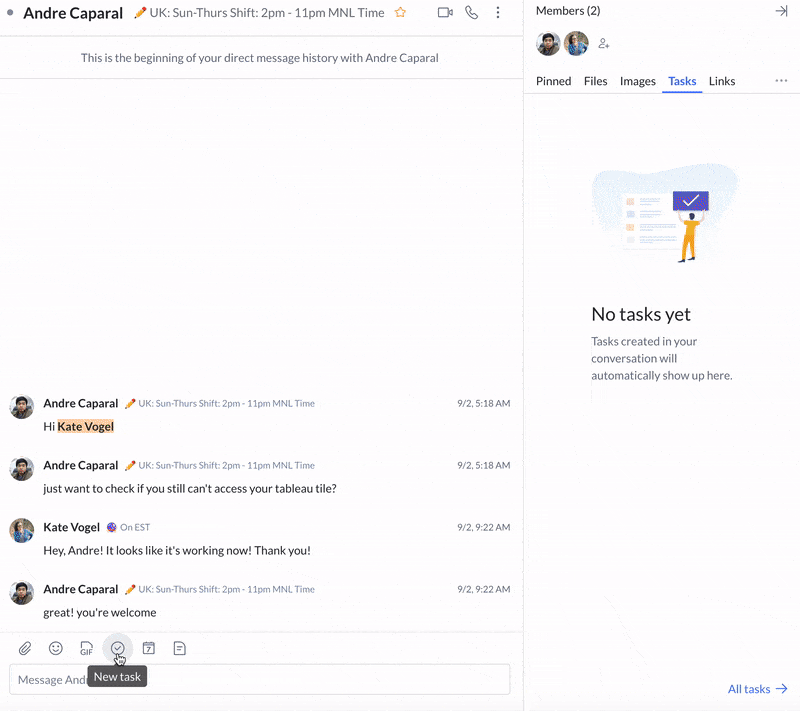Around 40% of managers surveyed by the Harvard Business Review said they don’t have the skills they need to manage a remote team.
Still, remote work is now common and popular because of the pandemic and because new technologies like productivity apps have made it easier to work from anywhere in the world. Many companies now let their employees work a few days remotely or let some teammates work remotely full-time while others work on-site.
Now that more companies are using this hybrid remote work model—sometimes called WFH 2.0 because it’s the model many companies are adopting after an entire year of remote work—team leaders need to tailor their management techniques for these teams’ unique characteristics to ensure their companies continue to thrive and grow.
Here are the hybrid remote work strategies for successful teams that we’ll talk about today:
- Normalize a hybrid remote work model
- Create a cohesive work culture for your hybrid remote team
- Delegate and coordinate your remote hybrid team effectively
- Empower your hybrid remote team
- Build a healthy and nurturing hybrid remote work environment
- Troubleshoot when your hybrid remote team encounters challenges
👀 Is your business really ready for hybrid work? Get set for success with our State of Hybrid Work report.
1. Normalize a hybrid remote work model
Managing a hybrid remote team effectively requires setting clear expectations to avoid misunderstanding and built-up resentment. Some colleagues might feel uncomfortable continuing to work remotely while others are returning to the office. Others might struggle to include their remote colleagues once they’ve returned to office work.
To make the transition as seamless as possible, brush up on communication techniques to keep things as transparent as possible. For example, consider establishing company policies that allow people to work remotely two days a week, or require that people who work remotely full-time obtain special permission from their managers.
Here are a few other ways to build a healthy hybrid remote work model:
- Set out transparent and equitable rules for who can work remotely and when, then make sure that everyone on your team knows the company policy. You can do that by emailing everyone a memo or posting the rules in an online channel that everyone uses to communicate.
- Don’t make remote work a privilege enjoyed only by your most senior teammates. That could cause some teammates to feel like you don’t trust them enough to allow them to work remotely. Remote work shouldn’t be a privilege, but rather an integral part of your company’s hybrid remote work culture.
- Normalize remote work by encouraging team leaders and managers to work off-site at least some of the time.
- Recruit and onboard employees remotely. Ensure that the process is the same for everyone, so you don’t accidentally create discrepancies between the way people are hired or shown the ropes. The goal is to standardize the process for everyone and avoid creating inequality.
Darcy Boles, an expert in remote company culture and the Director of Culture and Innovation at TaxJar, argues that companies should be “going hybrid with a remote-first mindset.” That means operating like a remote team even when many of your employees are working in the office.
“Spend at least a few days working outside of the office,” Boles suggests to managers. “Put yourself in the position of the people you’re managing.”
2. Create a cohesive work culture for your hybrid remote team
To create a healthy hybrid remote work culture, you must put extra effort into creating a connected culture between remote and office workers and strengthening the bonds between everyone, no matter where they are located.
Your company’s work culture can make or break your business. Nearly half of all job seekers surveyed said a good work culture is the number one thing they’re looking for in a prospective employer, according to a survey by Jobvite. And 88% of people surveyed said it’s a significant factor when deciding where to work.
One key way to create a connected hybrid remote work culture is to make sure that no one feels left out from the decision-making or creative process. That means ensuring everyone—remote or not—has an equal opportunity to participate in meetings, make decisions, and feel heard.
Here are a few tips for creating a cohesive hybrid remote work culture:
- Hold equitable meetings that include remote and on-site employees equally. Have everyone log into the meeting from their computer or other electronic devices, even if they’re in the same room. That way, the meeting format is the same for all team members, and everyone has an equal opportunity to give input.
- Avoid informal in-person meetings or making significant decisions that affect the whole team by holding informal watercooler discussions with only in-office teammates. That can make remote workers feel left out or undervalued.
- Organize ways for on-site and remote employees to socialize through virtual happy hours, watercooler talks, or virtual games. Remote happy hours can provide the kind of setting that connects team members, builds cohesion, and, ultimately, improves working relationships.
- Give people the opportunity to hear from people they don’t work with directly. Host casual meetings between colleagues on different teams.
- Use the right tools to coordinate workflow and facilitate open communication. RingCentral, for example, is a cloud communications app that allows you to message your colleagues or clients or speak to them via video or telephone—all from the same app. Other tools like Slack or Asana help with team communication and project management virtually.
Some companies implemented a hybrid remote work model and built a cohesive company culture even before the pandemic. Before the pandemic began, RingCentral allowed some of its employees to work a few days from home to make their commute more manageable, or so they could have more time for family responsibilities.
They implemented a hybrid remote work model, with some employees working remotely part-time and others working in the office all of the time, and used their company tools to foster communication.
Team members said the flexibility made their lives easier, and the company’s tool allowed them to form bonds with their colleagues and ensure that remote and on-site employees could hold their meetings in the same format.
The teammates developed remote support groups that focused on different topics and held meetings through RingCentral’s tools. That way, the hybrid remote work model didn’t negatively impact their team’s cohesion.
3. Delegate and coordinate your remote hybrid team effectively
People who are leading teams with a hybrid remote work model must develop specific skills and techniques that are tailored to this type of team, like shifting the way that you measure whether your team is working optimally.
One of the primary things you should do if you are managing a hybrid remote team is to create a straightforward process for measuring employee output in the same way for each employee so that the people you can see behind their desks aren’t judged differently from the people you can’t see, and vice versa.
That can mean weekly progress reports or daily check-ins, but the important thing is to ensure that everyone is doing the same thing, whether in the office or elsewhere.
Focusing on results rather than time logged, whether someone is in the office or not, can go a long way toward ensuring that your team runs smoothly. Someone can spend a lot of time in the office and not get anything done, or they could work two days from home and produce impactful work.
Having a central platform to communicate and manage projects is hugely important in a hybrid work setting. With RingCentral, you can share files and assign tasks within group chats and see whenever your teammates complete them, no matter where they’re logging in:

Another way to manage your hybrid remote team effectively is to focus on whether they have the tools they need to do their jobs.
“There are three psychological needs that humans have, no matter what industry they’re in,” says Boles, the expert in remote company culture. “You need autonomy, competency, and belonging. That’s it. So, if you’re a new manager, make sure you are focusing on these three things.”
“Are you making sure that this person feels like they belong? Are you making sure that they are challenged enough? Are they excited about the work that they’re doing? Are you giving them autonomy? Are you stepping away, giving them the tools and resources they need, and then letting them do it?”
It’s also important to create standard rules, schedules, and expectations for both remote and in-office employees. You should aim to level the playing field and normalize all kinds of work arrangements. One example would be to institute a rule that everyone, whether remote or on-site, must send their manager an update every afternoon on their progress or ongoing projects. That practice ensures everyone is treated equally and is expected to perform in the same way. Joe in the office doesn’t get a pass on sending his daily progress update just because his manager can see him behind his desk, for example.
Meanwhile, some experts note that it’s essential to promote remote and on-site employees equally and invest the same amount of time into their professional development.
“The trick is to be completely committed to their growth and development,” says Amie Devero, a professional management consultant with decades of experience coaching the leaders of tech startups.
4. Empower your hybrid remote team
According to research by RingCentral, only 1 in 10 employees are remote champions. These are people who are happier and more productive when working remotely. The key to empowering a team in a hybrid remote work environment is to find the 10% of your colleagues who thrive in a remote work environment and leveraging them as role models who can invigorate the rest of the team and lead by example.
You can identify a remote champion by looking for subtle cues, like whether your colleague is irritable or has trouble following through with ideas, or if they’re always brimming with enthusiasm and looking for ways to learn and improve.

Once you’ve figured out who your remote champions are, you can use them to boost the rest of your team. Designate them as advocates who communicate the needs of their team to management. Partner them with people who might be struggling. Create mentorship programs that let you leverage their enthusiasm.
One great way to ensure that one employee’s enthusiasm has a lifting effect for the rest of your team is by creating buddy programs in which team members can support each other.
If you partner thriving teammates with their struggling colleagues, it will allow these remote champions to serve as an example to others, experts say.
“I would partner people who are thriving with other people for different projects, because then you are leveraging what they’re good at to spread it around,” says Devero.
Make sure that you always ask your colleagues for input and be sure not to micromanage.
“Always ask your team. You hired these people for a reason,” Boles adds. “Your people have the answers.”
5. Build a healthy and nurturing hybrid remote work environment
Did you know that 68% of workers say poor work-life balance negatively impacts morale and motivation at work?
Successfully leading a team in a hybrid remote work environment means you’re also responsible for creating a compassionate environment that promotes wellness and balance—especially as teams continue to adjust to WFH 2.0. Giving your team the option to remotely work some of the time shows compassion to your employees. When you create a healthy and nurturing work environment, it reduces turnover and benefits your company and your teammates.
One way to nurture your hybrid remote team is to institute corporate wellness programs. These can include fitness stipends, yoga and mindfulness programs for employees, support in finding a therapist, or many other things.
According to a survey from software company Quantum Workplace, over 75% of engaged employees said they were also happy with the way their company supports their health and wellness.
Another way to do that is to provide increased flexibility for employees who are caretaking or juggling a lot of responsibilities at home.
Over one in six American workers also serve as caretakers, which means they take care of a child, a parent, or another person in their life.
Caretakers who work outside their home full-time often struggle to balance these responsibilities with their home lives. But one of the leading ways employers can demonstrate support for caretaking employees is by offering the flexibility of hybrid remote work options, which has been shown to boost employee happiness and productivity. Just be sure to give on-site employees the same flexibility as their remote counterparts.
The goal is to avoid having your colleagues get stressed and burnt out without your knowledge. Start normalizing conversations about work-life balance and open communication channels about workload management.
6. Troubleshoot when your hybrid remote team encounters challenges
If you find that something isn’t working—like you experience bottlenecks with workflow or communication is lagging—it’s essential to be flexible and know how to pivot to a strategy that works well for your team.
One way to figure out what works and what doesn’t is to ask your employees directly. You can then make changes based on this employee input. You could also run experiments and collect data to see what works.
When TaxJar hired new remote employees and discovered that they weren’t entirely comfortable juggling work meetings when their children might burst in, management took this concern on board and found a creative way to make their caretaking teammates feel more welcome.
“Our CEO had his six-year-old host the next company call,” Boles describes. “People on the team had their kiddos on their legs during the meeting.”
The move demonstrated to the team that the company is family-friendly and that it’s alright to participate in a meeting with your children nearby. Most importantly, it put people at ease so they could do their jobs remotely without worrying about whether their remote work environment made them appear less professional.
Managers should use their emotional intelligence to model the behavior they want to see, experts note.
“Remote doesn’t kill culture. It reveals it,” says Boles. “If you’re not working well remotely, there’s something that’s probably broken that you might not have seen before.”
Once you’ve identified what the issue is, you can deploy all of your management skills to fix it.
Hybrid work: It’s OK not to get it right the first time
It is possible to manage a hybrid remote team effectively with the right knowledge and skills, but don’t expect everyone to get it right immediately. Some teammates might be reluctant to return to the office after a year away, while others might be eager to return to the office but have a hard time immediately adapting their workflow to what feels like a new environment. Coordinating remote and on-site colleagues could also pose challenges at first.
Being an effective manager is often a question of trial and error, but this guide will set you on the path to leading your hybrid remote team to success.
Learn more about how to support your remote teammates with RingCentral’s Remote Work Playbook, or take a look at RingCentral’s tools for facilitating communication within a hybrid remote work environment.
Looking For Startup Consultants ?
Call Pursho @ 0731-6725516
Telegram Group One Must Follow :
For Startups: https://t.me/daily_business_reads




